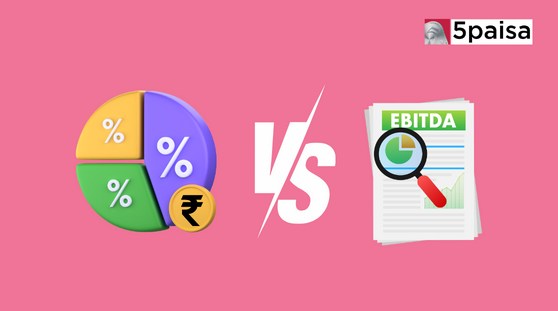Weekly Wrap-Up - Gaurav Munjal: Lone Wolf of Indian Edtech
Gross Profit Vs EBITDA

Last Updated: 30th May 2024 - 01:17 pm
When assessing a company's financial performance, investors and analysts often rely on various metrics to gain insight into its profitability and operational efficiency. Two prominent indicators, gross profit and EBITDA (Earnings Before Interest, Taxes, Depreciation, and Amortization), provide valuable perspectives on a company's earnings and overall financial health. While both metrics measure profitability, they differ in their calculation methods and the specific aspects of a business they evaluate.
What Is Gross Profit?
Gross profit is a straightforward calculation that reflects a company's income after deducting the direct costs associated with producing its goods or providing its services. It measures how effectively a company can generate profit from its direct labour and materials without considering other operational expenses.
The formula for calculating gross profit is:
Gross Profit = Revenue - Cost of Goods Sold
Revenue represents the total income earned from sales during a specific period, while the Cost of Goods Sold (COGS) includes expenses directly related to production, such as raw materials, direct labour costs, and utilities for the production facility.
Example Of Gross Profit Calculation
To illustrate, let's consider an example. Suppose a company, XYZ Ltd., had a total revenue of ₹10 million and a Cost of
Goods Sold of ₹6 million during the last quarter. In this case, XYZ Ltd.'s gross profit would be:
Gross Profit = ₹10 million - ₹6 million = ₹4 million
The gross profit figure provides insight into the company's ability to generate revenue from its core operations and manage the direct costs associated with production or service delivery. A higher gross profit margin generally indicates that a company efficiently manages its direct costs and pricing its products or services effectively.
What Is EBITDA?
While gross profit focuses solely on direct costs, EBITDA offers a broader perspective on a company's operational performance by factoring in additional expenses beyond direct production costs. EBITDA stands for Earnings Before Interest, Taxes, Depreciation, and Amortization, and it serves as a proxy for a company's earning potential and cash flow generation.
The formula for calculating EBITDA is:
EBITDA = Operating Income + Depreciation + Amortization
Operating income represents a company's profit after deducting all operating expenses, including indirect costs such as administrative, marketing, and research and development expenses. By adding back depreciation and amortization, which are non-cash expenses, EBITDA provides a clearer picture of a company's operational cash flow and profitability before accounting for financing costs (interest) and tax obligations.
Example Of EBITDA Calculation
Let's assume that XYZ Ltd. had an Operating Income of ₹2 million, Depreciation of ₹0.5 million, and Amortization of ₹0.3 million during the same quarter. The company's EBITDA would be calculated as follows:
EBITDA = ₹2 million + ₹0.5 million + ₹0.3 million = ₹2.8 million
EBITDA is particularly useful for comparing profitability across companies or industries, as it eliminates the effects of financing decisions and accounting treatments related to depreciation and amortization. It provides a more comprehensive view of a company's operational efficiency and its ability to generate cash flow from its core business activities.
Advantages of Using Gross Profit and EBITDA
Both gross profit and EBITDA offer distinct advantages in financial analysis:
Gross Profit:
● Evaluate the direct profitability of a company's core operations.
● Helps assess the efficiency of managing direct production costs and pricing strategies.
● Provides insights into the company's ability to generate revenue from its primary business activities.
EBITDA:
● Offers a broader perspective on operational performance by including indirect costs.
● Allows for better comparison of profitability across companies and industries.
● Provides a clearer view of a company's cash flow generation and earning potential.
● Eliminates the impact of financing decisions and non-cash expenses (depreciation and amortization).
Differences Between Gross Profit and EBITDA
While both gross profit and EBITDA measure profitability, they differ in their calculation methods and the specific aspects of a company's financial performance they evaluate:
● Cost Inclusions: Gross profit only considers direct production costs, such as raw materials and direct labour, while EBITDA accounts for all operating expenses, including indirect costs like administrative and marketing costs.
● Scope of Analysis: Gross profit focuses solely on the profitability of a company's core operations, while EBITDA provides a more comprehensive view of operational performance and cash flow generation.
● Non-Cash Expenses: EBITDA adds back depreciation and amortization expenses, which are non-cash items, to provide a clearer picture of a company's cash flow. Gross profit does not consider these non-cash expenses.
● Comparability: EBITDA is generally more useful for comparing profitability across companies and industries, as it eliminates the effects of financing decisions and accounting treatments related to depreciation and amortization. Gross profit may be less comparable due to differences in cost structures and pricing strategies.
Conclusion
Both gross profit and EBITDA are valuable financial metrics that offer distinct insights into a company's profitability and operational performance. While gross profit provides a focused view of direct profitability from core operations, EBITDA offers a more comprehensive perspective by including indirect costs and accounting for non-cash expenses. By considering both metrics, investors and analysts can better understand a company's financial health, operational efficiency, and potential for cash flow generation.
Frequently Asked Questions
Are There Any Limitations or Criticisms Associated with Using Gross Profit or EBITDA as Financial Metrics?
What Expenses Are Included in Gross Profit, and What Are Excluded?
Why Is Gross Profit Important for Businesses, and How Does It Impact Financial Analysis?
- Flat ₹20 Brokerage
- Next-gen Trading
- Advance Charting
- Actionable Ideas
Trending on 5paisa
Business and Economy Related Articles
Disclaimer: Investment in securities market are subject to market risks, read all the related documents carefully before investing. For detailed disclaimer please Click here.
 5paisa Research Team
5paisa Research Team
 Sachin Gupta
Sachin Gupta




